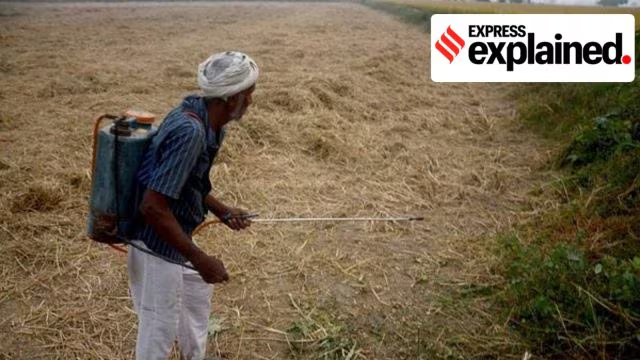Tags
Punjab’s paddy procurement hits five-year low: why record acreage couldn’t meet the target
Despite recording the highest-ever area under rice cultivation this year, Punjab is expected to face a shortfall in paddy procurement by 14 LMT. We explain.
Written by Anju Agnihotri Chaba.

Punjab, a state renowned for its significant contribution to India’s foodgrain pool, is set to witness one of the lowest paddy procurements in the past five years. This development comes despite the state recording the highest-ever area under rice cultivation this year.
The state has procured 172.16 lakh metric tonnes (LMT) of paddy so far, significantly below the expected target, while paddy harvesting is nearly complete. While paddy procurement in the state will continue till November 30, only a minimal quantity of paddy has arrived in mandis for this purpose.
Why is Punjab facing its lowest procurement in recent years despite the highest rice acreage? We explain.
Why is Punjab unlikely to meet the target even with ongoing procurement?
The centre has fixed an estimated target of 185 lakh metric tonnes (LMT) of paddy for the 2024-25 season, almost similar to last year’s figure. This estimate was based on approximately 32 lakh hectares under rice cultivation, including over 25 lakh hectares of paddy (non-basmati) and around 6.4 lakh hectares of Basmati, an aromatic variety not procured by the government.
However, paddy arrivals to the state have thus far been a trickle: On November 27, only 50,600 tonnes arrived in mandis, compared to 6-7 lakh tonnes per day during the peak period (October 20 to early November). With arrivals drastically reduced, reaching the target of 185 LMT is impossible.
Punjab is expected to fall short by around 14 LMT, marking one of the lowest procurement levels since 2020.
How does this season compare with previous years?
Here is a look at Punjab’s rice area and paddy procurement over the past five years:
| Year | Area (Lakh Hectares) | Procurement (LMT) |
| 2024-25 | 32.00 | 172.16 (till Nov 27) |
| 2023-24 | 31.87 | 184.93 |
| 2022-23 | 30.98 | 182.96 |
| 2021-22 | 29.69 | 189.08 |
| 2020-21 | 29.28 | 204.83 |
Why is there a shortfall in procurement?
Procurement delays: Early in the procurement season, issues with rice shellers caused delays in procurement.
Rice mills, tasked with the storage of the procured paddy and handing over rice to the Food Corporation of India (FCI) after milling, refused to store it in their respective mills.
Last year the government took the delivery of rice till September 30, 2024, while the next paddy procurement began on October 1. Millers however would take delivery of rice only by March 31st. Thus farmers who brought their crops to mandis in the intervening period were either met with delays or offered ₹150-200 less than the Minimum Support Price (MSP).
Fearing a similar situation, many farmers delayed harvesting their crops hoping to avoid low prices. This delay impacted the moisture levels in paddy, which is critical for achieving higher yields.
Moisture level issues: Paddy is typically harvested at 21-22% moisture level and sold at 17-18% moisture. However, delayed harvesting reduced moisture levels to 14-15%, leading to lower yield. Farmers expected 30-32 quintals per acre but ended up with 2-5 quintals less per acre.
Dharminder Singh, a farmer from Sangrur who spoke to The Indian Express said, “I was expecting 36 quintals per acre with 131 and Pusa-44 varieties, but I only got 32 quintals, a loss of four quintals per acre and my fellow farmers even faced losses of 5-6 quintals per acre due to delayed harvesting.” He also said that at the milking of grain stage, there was a higher temperature this year which also affected the yield a bit.
Decline in paddy from other states: The problem was compounded by restrictions on the transport and sale of paddy from states which do not have the MSP facility. Previously, traders would bring large quantities of paddy from other states at a lower rate and sell it at MSP in Punjab’s mandis.
Experts believe that stricter enforcement of procurement policies and the absence of paddy from other states significantly contributed to the shortfall in paddy procurement. They added that while Punjab has seen one of the highest areas under paddy this year, multiple systemic issues have led to a significant shortfall in procurement, impacting both farmers’ earnings and the state’s contribution to the central grain pool.
https://indianexpress.com/article/explained/punjab-paddy-record-low-9695475/
Published Date: November 29, 2024






